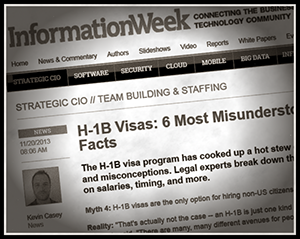If you follow a single issue closely as I do, you can get a clear understanding of how bad the American press is. If the press's accuracy on H-1B is representative of what they report elsewhere, the public is getting fed a lot of garbage.

Generally, the trade press is better on H-1B. However, InformationWeek this week gives us a prime example of disinformation.
With the confidence of a Holocaust denier, Kevin Casey tells us it is a myth that "H-1B visas replace American workers with cheap foreign labor."
Clearly Casey has never worked in the industry. I have watched Americans being replaced by H-1B workers first-hand because the employer could get them cheaper. My next-door neighbor was replaced by H-1B workers. I know a lot of others who have been H-1B'd as well. Either Casey is purposely telling us a lie or he is pontificating about something of which he knows nothing.
Casey enhances his deception by making the weasel-word statement that H-1B pay rates are "often based on the Department of Labor's wage database". Then he links to the Bureau of Labor Statistics website where one can find the prevailing wage. The implication is that this is what employers use for H-1B wages.
But that is not where employers usually get their H-1B prevailing wage. That website is flcdatacenter.com (yes, .com). While the wages at flcdatacenter.com are based on the BLS data, it provides much lower wages.
Let's look at this difference. If you go to the website Casey sends his readers to, the prevailing wage for a programmer in the New York area is $87,680. If you go to flcdatacenter.com, you find that the employer can legally claim that $56,597 is the prevailing wage for an H-1B visa. That's a $31,083/year potential savings by going H-1B. Most employers do go a little above that for the H-1B wage, but the average H-1B wage by location and occupation remains much less than the actual prevailing wage.
